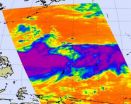(Press-News.org) The world at large runs on lithium ion batteries. New research at Rice University shows that tiny worlds may soon do the same.
The Rice lab of Professor Pulickel Ajayan has packed an entire lithium ion energy storage device into a single nanowire, as reported this month in the American Chemical Society journal Nano Letters. The researchers believe their creation is as small as such devices can possibly get, and could be valuable as a rechargeable power source for new generations of nanoelectronics.
In their paper, researchers described testing two versions of their battery/supercapacitor hybrid. The first is a sandwich with nickel/tin anode, polyethylene oxide (PEO) electrolyte and polyaniline cathode layers; it was built as proof that lithium ions would move efficiently through the anode to the electrolyte and then to the supercapacitor-like cathode, which stores the ions in bulk and gives the device the ability to charge and discharge quickly.
The second packs the same capabilities into a single nanowire. The researchers built centimeter-scale arrays containing thousands of nanowire devices, each about 150 nanometers wide. A nanometer is a billionth of a meter, thousands of times smaller than a human hair.
Ajayan's team has been inching toward single-nanowire devices for years. The researchers first reported the creation of three-dimensional nanobatteries last December. In that project, they encased vertical arrays of nickel-tin nanowires in PMMA, a widely used polymer best known as Plexiglas, which served as an electrolyte and insulator. They grew the nanowires via electrodeposition in an anodized alumina template atop a copper substrate. They widened the template's pores with a simple chemical etching technique that created a gap between the wires and the alumina, and then drop-coated PMMA to encase the wires in a smooth, consistent sheath. A chemical wash removed the template and left a forest of electrolyte-encased nanowires.
In that battery, the encased nickel-tin was the anode, but the cathode had to be attached on the outside.
The new process tucks the cathode inside the nanowires, said Ajayan, a professor of mechanical engineering and materials science. In this feat of nanoengineering, the researchers used PEO as the gel-like electrolyte that stores lithium ions and also serves as an electrical insulator between nanowires in an array.
After much trial and error, they settled on an easily synthesized polymer known as polyaniline (PANI) as their cathode. Drop-coating the widened alumina pores with PEO coats the insides, encases the anodes and leaves tubes at the top into which PANI cathodes could also be drop-coated. An aluminum current collector placed on top of the array completes the circuit.
"The idea here is to fabricate nanowire energy storage devices with ultrathin separation between the electrodes," said Arava Leela Mohana Reddy, a research scientist at Rice and co-author of the paper. "This affects the electrochemical behavior of the device. Our devices could be a very useful tool to probe nanoscale phenomenon."
The team's experimental batteries are about 50 microns tall -- about the diameter of a human hair and almost invisible when viewed edge-on, Reddy said. Theoretically, the nanowire energy storage devices can be as long and wide as the templates allow, which makes them scalable.
The nanowire devices show good capacity; the researchers are fine-tuning the materials to increase their ability to repeatedly charge and discharge, which now drops off after a about 20 cycles.
"There's a lot to be done to optimize the devices in terms of performance," said the paper's lead author, Sanketh Gowda, a chemical engineering graduate student at Rice. "Optimization of the polymer separator and its thickness and an exploration of different electrode systems could lead to improvements."
Rice graduate student Xiaobo Zhan is a co-author of the paper.
###
The Hartley Family Foundation, Rice University, National Institutes of Health, Army Research Office and Multidisciplinary University Research Initiative supported the research.
Read the abstract at http://pubs.acs.org/doi/abs/10.1021/nl2017042
Download high-resolution images at
http://www.media.rice.edu/images/media/NEWSRELS/0728_Hybrid_electrochemical_device.jpg
http://www.media.rice.edu/images/media/NEWSRELS/0728_nanowire.jpg
CAPTIONS:
(Photo)
An ultrathin battery/supercapacitor hybrid contains thousands of nanowires, each of which is a fully functional battery. The Rice University lab of Pulickel Ajayan developed the device. (Credit: Jeff Fitlow/Rice University)
(Illustration)
A schematic shows nanoscale battery/supercapacitor devices in an array, as constructed at Rice University. The devices show promise for powering nanoscale electronics and as a research tool for understanding electrochemical phenomenon at the nanoscale. (Credit: Ajayan Lab/Rice University)
END
CINCINNATI—New University of Cincinnati (UC) research on HIV testing at local emergency departments shows that hospitals miss opportunities to diagnose patients who do not know they are infected with HIV, even when a regular testing program is in place.
The study is part of a special supplement to the July issue of Annals of Emergency Medicine, sponsored by the Centers for Disease Control and Prevention (CDC). The supplement includes a series of studies on HIV testing in the nation's emergency departments, finding that while a growing number of emergency departments (EDs) ...
New Rochelle, NY, July 29, 2011–Intravenous delivery of cold fluids to reduce body temperature quickly after a heart attack and improve neurologic outcomes may not be as effective in children as it is in adults, according to a study reported in Therapeutic Hypothermia and Temperature Management, a peer-reviewed journal published by Mary Ann Liebert, Inc. The article is available free online at www.liebertpub.com/ther
In adults, therapeutic hypothermia to minimize neurological complications caused by cardiac arrest can be achieved by rapidly infusing cold (4oC) intravenous ...
Los Angeles, CA (July 29th, 2011) – The city of Liverpool made a bold move in investing in exhibiting at the 2010 World Expo in its twin city of Shanghai, China. According to research in the journal Local Economy published by SAGE, the city is beginning to reap the benefits both of inward investment, and of a higher profile in, and strengthened relationships with China.
Liverpool was the only city in the UK to take the decision to promote itself at the 2010 World Expo, in the economically dynamic city of Shanghai, in a country whose economy is growing faster than any ...
SANTA CRUZ, CA--Although high-temperature superconductors are widely used in technologies such as MRI machines, explaining the unusual properties of these materials remains an unsolved problem for theoretical physicists. Major progress in this important field has now been reported by physicists at the University of California, Santa Cruz, in a pair of papers published back-to-back in the July 29 issue of Physical Review Letters.
The first paper, by UCSC physicist Sriram Shastry, presents a new theory of "Extremely Correlated Fermi Liquids." The second paper compares calculations ...
Patients suffering REM sleep behaviour disorders dream nightmares in which they are attacked and pursued, with the particularity that they express them by screaming, crying, punching and kicking while sleeping. Lancet Neurology has published the third consecutive work in five years about the relationship between this disorder and Parkinson's disease. The first work showed in 2006 that 45% of patients who suffer this sleep disorder develop Parkinson's disease and other neurodegenerative diseases caused by a lack of dopamine in the brain. The second article discovered that ...
PHILADELPHIA — Even in trace quantities, the radioactive gas radon is very dangerous; it is second only to cigarette smoking as a cause of lung cancer deaths in the United States. The expense and precautions necessary to study it safely have limited research into its properties. Now, University of Pennsylvania chemists have for the first time measured how well radon binds to a molecule, paving the way for future research on it and other noble gasses.
The research was led by associate professor Ivan J. Dmochowski, along with undergraduate Vagelos Scholar David R. ...
The width of an image from the AIRS instrument that flies on NASA's Aqua satellite is about 1700 km (1056 miles), and the clouds and thunderstorms associate with Tropical Storm Muifa take up that entire distance on today's imagery.
Tropical Storm Muifa is spinning through the western North Pacific Ocean today and has grown in size. When NASA's Aqua satellite passed over the storm on July 29, 2011 at 04:17 UTC (12:17 a.m. EDT) it measured the temperatures in the cloud tops. Those cloud top temperatures especially in the east and western sides of the tropical storm were ...
NASA is analyzing Tropical Storm Don from all angles, inside and out, using three different satellites. Don is expected to make landfall in southeastern Texas tonight or early Saturday.
NASA's Aqua satellite passed over Tropical Storm Don at 8:17 UTC (4:17 a.m. EDT) on July 29. The instrument called the Atmospheric Infrared Sounder (AIRS) took the temperature of Don's clouds in an infrared image. AIRS data revealed a large area of powerful, high thunderstorms with cold cloud tops surrounding Don's center where cloud temperatures were colder than -63 Fahrenheit (-52 Celsius). ...
The following highlights summarize research papers that have been
recently published in Geophysical Research Letters (GRL); Space
Weather; Geochemistry, Geophysics, Geosystems (G-Cubed); Journal of Geophysical Research-Biogeosciences (JGR-G); Journal of Geophysical Research-Earth Surface (JGR-F); Journal of Geophysical Research-Space Physics (JGR-A) and Water Resources Research (WRR).
In this release:
What do sea measurements reveal about Earth's temperature trend?
Japan's big earthquake shook the ionosphere
Miniature detector measures deep space radiation
New ...
Replacing gasoline and diesel with plant-based bio fuels is crucial to curb climate change. But there are several ways to transform crops to fuel, and some of the methods result in bio fuels that are harmful to health as well as nature.
Now a study from the University of Copenhagen shows that it is possible to predict just how toxic the fuel will become without producing a single drop. This promises cheaper, faster and above all safer development of alternatives to fossil fuel.
Solvejg Jorgensen is a computational chemist at the Department of Chemistry in Copenhagen. ...




